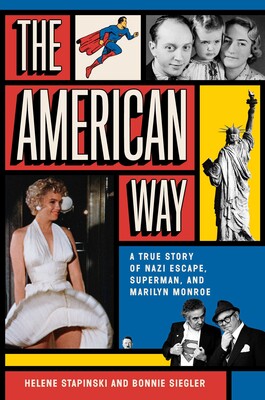The American Way: A True Story of Nazi Escape, Superman, and Marilyn Monroe
- By Helene Stapinski and Bonnie Siegler
- Simon & Schuster
- 384 pp.
- Reviewed by Helene Meyers
- March 14, 2023
A sensational tale of gumption, luck, and celebrity.

Toward the end of The American Way, Jules Schulback, a “proud Berliner” despite his narrow escape from Nazi Germany, accepts an award for his lifetime of community work and gives a speech about the connective power of stories: “If you dug down deep enough, your story was intertwined with every other person’s story.” That line is not only the genuinely held belief of Jules but also the method of this work of creative nonfiction by Helene Stapinski and Jules’ granddaughter, Bonnie Siegler.
In 1954, Jules films Marilyn Monroe being filmed by fellow refugee Billy Wilder; in fact, Jules captures in color the iconic “Seven Year Itch” footage of Monroe standing above a subway grate, with her billowing dress taking on a life of its own. The sponsor who enables Jules to escape to the U.S. is none other than Harry Donenfeld, the publisher of Superman, who cheats Joe Shuster and Jerry Siegel out of their fair share of the profits for creating an iconic American superhero. These interwoven threads and the large cast of characters that flows from them make up The American Way and give rise to its subtitle, A True Story of Nazi Escape, Superman, and Marilyn Monroe.
Following the conventions of comic books, The American Way provides the origin stories for almost all of its players. Along with Jules, we learn about his sister Golda and her extended family, as well as about Edith, Jules’ beloved wife, and her family. We get, too, the backstories of Donenfeld, his criminal associates, and his wife and mistress. If this sounds like a lot, it’s because it is — indeed, the “cast of characters” at the beginning of the book runs a full three pages.
The frontloading of all these origin stories makes for a slow start to this episodic tale. However, the reader who slogs through is rewarded with a moving chronicle of those who survive the Shoah by coming to America, and those who perish at the hands of genocidal bureaucrats. Long before Jules makes his 10-block walk through the streets of New York to film Monroe and her unruly dress, Hollywood changes his life: It is by pretending to be Clark Gable’s agent and using Hitler’s love of movies to intimidate Nazi border guards that he is able to get his wife and daughter to safety.
For Jules, the American way is nothing less than the American Dream. Sending his daughters to summer camp became a miraculous symbol of being “saved from an alternate universe where the word ‘camp’ had a very different meaning.” However, for Shuster and Siegel, naively signing away their rights to Superman, “the original sin of comic books,” was an “American nightmare.” Yet, as Stapinski and Siegler rightly note, that nightmare was “simply a matter of contract law. The American Way.”
Similarly, when Joe DiMaggio witnesses his then-wife Monroe being ogled at the subway-grate shoot and beats her up later that night in their hotel, no one who hears her screams thinks to call the police. “Wife beaters were an accepted part of American life,” the authors write.
Throughout the book, Stapinski and Siegler provide an admirably nuanced depiction of the American way in the 20th century. Just as importantly, they movingly recreate the horrific impact of the Shoah on so many Jewish families, and the prelude to genocide: “People’s hatred, once masked behind a fake civility, was now raw and out in the open. Jules was cursed at, spat at, not just by his enemies, but by his former friends.” As memory of the Holocaust wanes in some quarters and antisemitism surges, the significance of such narrative work should not be underestimated.
The authors also do justice to the complexity of Monroe, paying close attention not only to her seductiveness as a celebrity but also to her ambition and intelligence. Given their propensity for telling subtle stories, then, their occasional trading in stereotypes is jarring. For example, when they discuss Tom Ewell, Monroe’s co-star in “The Seven Year Itch,” they glibly write, “Not to put too fine a point on it, he was gay. Ewell was probably the only guy on The Seven Year Itch shoot who didn’t want to get into the Girl’s frozen panties.” Similarly, they describe Faye Sternberg, Jules’ second cousin and the woman who convinced Donenfeld to become Jules’ sponsor, as a “princess who never cooked and either ate out or ordered in Jewish deli.”
While lines like these miss their mark, The American Way is overall an entertaining and educational melding of many counterintuitively interconnected histories. Short chapters make for an accessible if sometimes fragmented read. And fabulous photos abound, including one of a dapper elder Jules at the beginning of the 21st century. Given that The American Way sits at the intersection of Holocaust, Hollywood, and comic-book history, it should find a devoted and diverse readership.
Helene Meyers is professor emerita of English at Southwestern University, where she held the McManis University Chair. Her recent book is Movie-Made Jews: An American Tradition.
